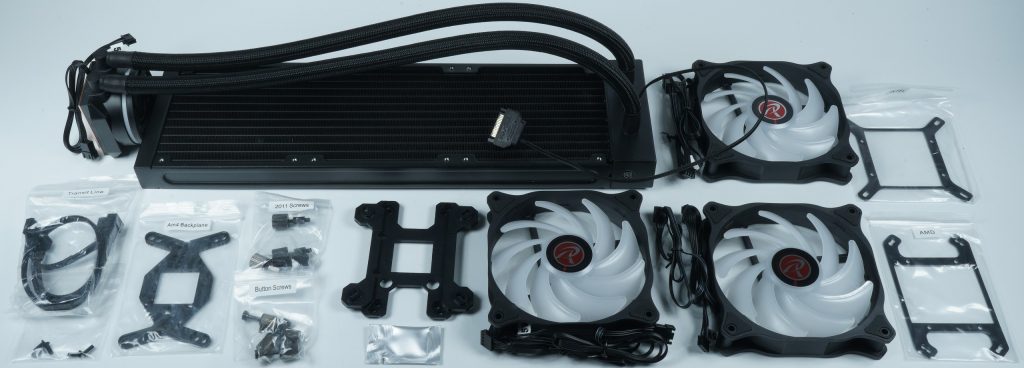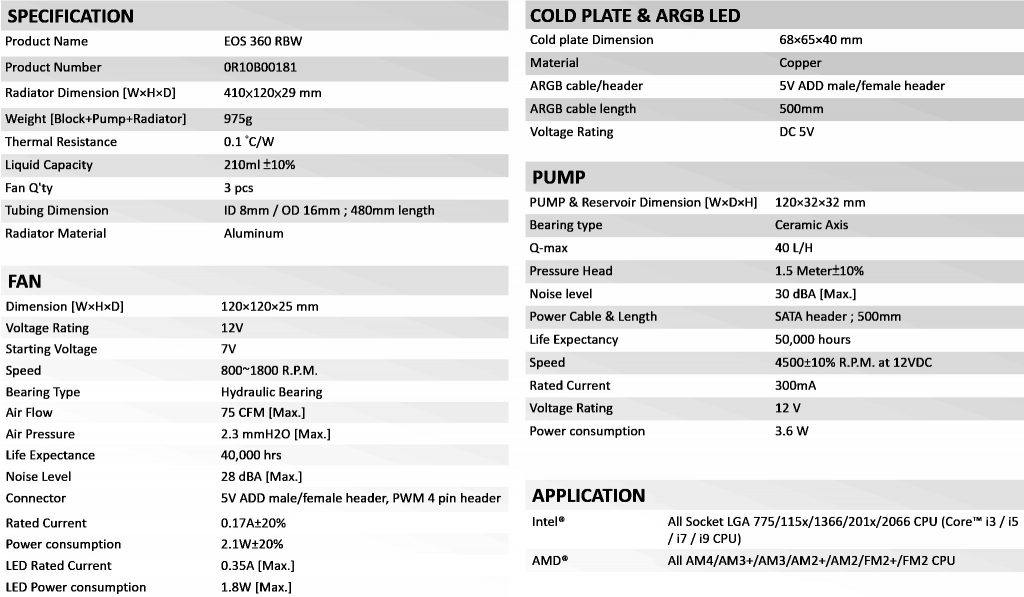 The last generation of the AiO now sends Raijintek into the orcus and delights the bargain-hunting PC-Bastler with the EOS 360 RBW, which is also available as a 240 and which would actually be quite sufficient. But the customer still seems to like to have the longest, which is why it was possible to set off more longer models from the Orcus. A price of 89 euros (or 74 Euro of the EOS 240) for a fully equipped 360 AiO with aRGB luminosity on all 3 propellers and the radiator housing are an announcement. Cheap or just cheap? That is what we are going to be doing today.
The last generation of the AiO now sends Raijintek into the orcus and delights the bargain-hunting PC-Bastler with the EOS 360 RBW, which is also available as a 240 and which would actually be quite sufficient. But the customer still seems to like to have the longest, which is why it was possible to set off more longer models from the Orcus. A price of 89 euros (or 74 Euro of the EOS 240) for a fully equipped 360 AiO with aRGB luminosity on all 3 propellers and the radiator housing are an announcement. Cheap or just cheap? That is what we are going to be doing today.
Of course, the radiator is made of aluminum, even the channels in the heat exchanger, otherwise you would never be able to hit this price point. As always, it will have to adjust the addition of the liquid, even if one must of course see a long-term operation of several years more critically than with an open full copper solution with refill possibility. But as long as you don't plan a build for eternity, the EOS 360 RBW is no worse or better than the rest of these products.
Important preliminary remarks
On the test methodology and the measurement setup in detail, I come straight to page 2, but I have to make a small preliminary remark at the beginning. This and the further tests are designed as practically as possible, including the obvious, this AiO cooler with precisely staggered loads (instead of any fixed clock rates or fan speeds) and optimized for the current system. Fan curves on an Intel enthusiast system with very high power dissipation and rather low heat flux density, as well as a current Ryzen 9 system with extremely high heat flux density and thermal limitation.
You simply need both systems in order to be able to judge objectively later on. This applies in particular to the assessment of the cold plate. Of course, the higher the heat flux density, the more important are the areas directly cooled by the water in order to dissipate the waste heat from the heat sink as quickly as possible. Maintaining this performance when it comes to heat exchange on the radiator is the logical follow-up task that causes far fewer problems for the Intel system. The AMD system generates very asymmetric loads, which also require the coolers very differently. I compare the Raijintek EOS 360 in this review with the NH-U12A as an air cooler and the Alphacool Polar Bear 360 as compact water cooling (both with series fans).
Scope of delivery and construction of the EOS 360
The first and second glance reveals it quite quickly: Raijintek has changed the supplier completely for the EOS this time. The background will certainly be discussed at some point, but the attentive reader will surely have already noticed that the Orcus clones of Enermax and Cougar are not really what one wants from your producer as a company. Illegitimate children and surrogate mother births belong in the gossip press, but not in their own shelves.
You get the unit of radiator and pump with the two permanently connected hoses and just over 40 cm real usable hose length including the CPU cooler, which together weighs almost one kilogram with 975 grams (without fan). The three PWM-controlled fans with aRGB and hydraulic bearingrun run at approx. 600 rpm clean, but only develop a usable throughput above 800 rpm. The maximum speed of 1800 rpm is not needed, but some reserve due to a high speed band can never hurt.
You get mounting kits for all current sockets and also many older systems. However, only the system for the socket 2066 (2011) is really stress-free. The supplier does not rely on AMD's solid backplate, but uses its own plastic solution, which must first be attached to the motherboard with its own screws. With a little thought, this could easily have been avoided, but this solution will of course hold. The CPU cooler itself does not include a pump, because it sits in the radiator and is supplied directly and unregulated by a SATA power supply connection with 12 volts. This also avoids the usual Asetek patent trolls.
The coldplate made of copper is quite large for an AiO and also dispenses with nickel plating. For this, there is a nice aRGB illumination in the radiator lid free of the house. The colorful light vegetables are connected via proprietary 4-pin plugs and sockets, which can be cascaded from fan to fan and fan to pump. The last free plug then belongs on the motherboard, whereby the 4-pin also fits on the 5V-RGB with the Preci-Dips. You just have to pay attention to the right pole! The brackets for the respective base are simply screwed into the radiator housing with 4 short screws.
The radiator is made entirely of aluminium and offers a total of 6 circulating channels in each direction, resulting in a total of 12. The supplier (unfortunately) dispenses with small fuse plates under the threaded openings for the screwing of the fans or on the housing. The fans are each provided with 4 matching screws including washer, as well as 4 housing screws. In the absence of stoppers, one should really only use what the manufacturer offers itself, because screws can spear into the slats for too long. At least there is no channel below the threaded openings, so that you can't cause any further damage except crushed slats.
Here again the technical data of the AiO cooling and the fans at a glance:
The exact descriptions and marketing hints have been summarized again as PDF:
RAIJINTEK EOS 360 RBW introduction saleskit 20190919Raijintek Eos 360 RBW, RGB Rainbow, 360mm (0R10B00181)
| HardwareRat | Lagernd | 89,90 €*Stand: 25.07.24 14:32 |
Raijintek Eos 240 RBW, RGB Rainbow, 240mm (0R10B00174)








































Kommentieren